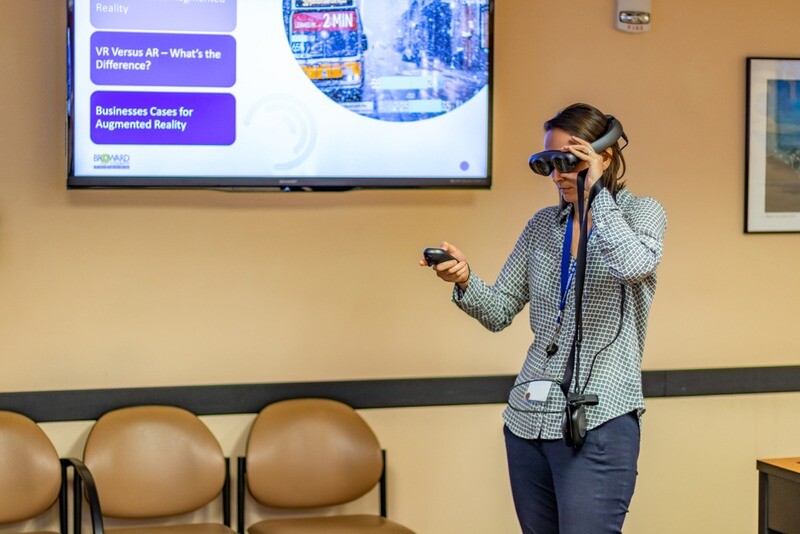Around this time last year, Magic Leap publicly launched their updated augmented reality (AR) platform, Magic Leap 2, which was included among TIME Magazine’s top 200 inventions of 2022. Earlier this month, the enterprise-focused AR company has released new updates to their Magic Leap 2 platform which they say will “enable greater collaboration and productivity, deeper immersion, and easier development.” These updates include new capabilities – namely AR Cloud and a new native web browser – as well as improvements to existing features.
The launch of their new AR Cloud capability is something which Magic Leap says will “take remote collaboration to a new level with shared, persistent digital content.” With AR Cloud, stakeholders on a project will have the ability to simultaneously view the same large-scale digital content in real-time, all integrated to physical environments. To make this possible, AR Cloud utilizes the sensor and camera stack of Magic Leap 2 to compile detailed scans and meshes of the physical world into Shared Spaces.
In addition to being able to co-present experiences, AR Cloud also allows for significantly larger spatial maps – more than 10,000 square meters, compared to a limitation of five Local Spaces of around 250 square meters without AR Cloud – along with access to an unlimited amount of Shared Spaces (only five can be stored locally), and the ability to export textured mesh scans of a space in USD file format.
Also included in this announcement is the news that the company is introducing a new native web browser for Magic Leap 2. Now, users will have the ability to access information on the web using the Magic Leap 2 platform, as well as being able to host WebRTC video conferencing, collaboration using Microsoft Teams and Google Meet, play videos from the web, and interact with WebXR content. The new web browser displays sites at a 1065 x 616px resolution and supports downloads. Users can access the web browser now with the latest Magic Leap 2 OS release.
AR Cloud and the new web browser are the headlining additions to the Magic Leap 2 platform, but the company also announced a handful of improvements to existing capabilities as well.
Magic Leap is working with MRTK and Unity to simplify the process for developers to port applications to Magic Leap 2, or build for multiple devices at the same time. The most recent release includes improved MRTK examples, exposed handedness values, supported Microsoft AirTap gesture, and exposed Voice Intent support for Slots.
Hand tracking has received some improvements to make interacting with digital content within the Magic Leap 2 platform more intuitive. Specifically, they’ve improved the stability of hand keypoints and in varying lighting conditions for smoother hand tracking and reduced latency, as well as introducing a new “wrist tap” gesture to simplify the process of opening the home menu by just requiring a user to tap their index finger to the opposite hand’s wrist.
Magic Leap has improved their Dynamic Dimming technology to automatically adjust based on ambient light conditions for the user.
They’ve improved Magic Leap 2’s mixed reality capture capabilities, which allow users to take photos and videos within an in-device experience to display both the real-world view and overlaid digital content.
Over the course of multiple upcoming releases, developers will have expanded access to sensor data – including RGB camera, world cameras, depth sensors, eye cameras, and more – along with increased data transparency measures.
The use of wearable AR in enterprise settings is still something of a contentious subject, with some firms fully embracing it while others still preferring more traditional methods, or at least using mobile devices and tablets to overlay digital views over the physical environment. Magic Leap 2 did make some strides towards making the idea more accessible, though, with a sleeker design to improve the physical feelings of wearing glasses throughout a day, or at least for parts of it. Firms and organizations are only going to become more interested in these kinds of solutions, though, as 3D visualization tools become more powerful and ubiquitous.
Now, the company is taking the platform to the next level with these new updates, particularly with AR Cloud and the web browser. Both of these figure to improve collaboration, which for the AEC industry in particular is a must. By allowing more stakeholders to view the same visuals easily, and utilizing the cloud more to allow for more storage and collaboration, will only serve to make projects run more smoothly and prevent potential errors leading to delays and budget overtures. This is a space that is only going to grow over the next few years, and Magic Leap is showing that they recognize the need for continuous improvement for their platform.






